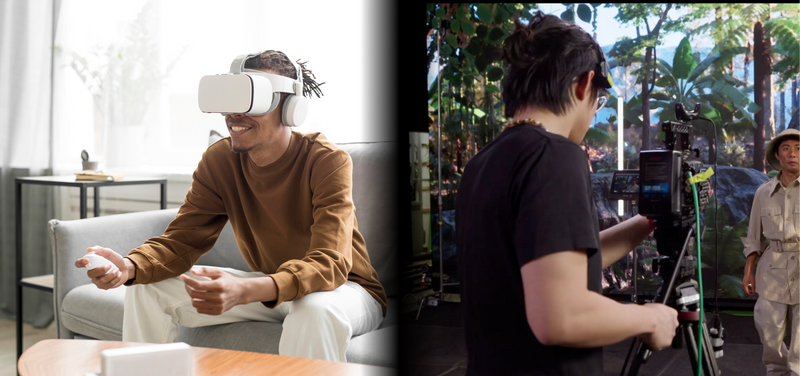What is the difference between AR and VR - AR vs VR

The debate of AR vs VR often creates confusion because both technologies fall under the category of immersive experiences. However, they are fundamentally different in how they interact with our world. Augmented Reality (AR) works by layering digital content on top of the real environment. For example, if you use your smartphone to project a piece of furniture into your living room, you are experiencing AR. It enhances what you already see without removing you from your surroundings.
On the other hand, Virtual Reality (VR) takes you out of the real world entirely and places you inside a computer-generated environment. By putting on a VR headset, you are transported into a simulation that could be anything from a video game universe to a medical training program. The primary difference between AR and VR is simple: AR adds digital information to your reality, while VR replaces reality with a virtual one.
AR vs VR Comparison: Features and Applications
Although both AR and VR are built on the idea of immersion, the way people experience them varies significantly. Augmented Reality keeps you grounded in your physical space while introducing useful or entertaining digital elements. This is why it has gained popularity in industries such as retail, where customers can try on clothes virtually, or in real estate, where potential buyers can see how furniture fits inside a home before purchasing.
Virtual Reality, in contrast, disconnects you from the physical world and provides a complete digital experience. In the world of gaming, this has been revolutionary, allowing players to step into fantasy environments and interact with them in ways that were never possible before. Beyond gaming, VR has also become a powerful tool for training and education. Surgeons can practice operations in a risk-free digital space, and businesses can train employees through simulated scenarios that feel realistic yet safe.
When you look at an AR vs VR comparison, it becomes clear that AR is about enhancing what already exists, while VR is about escaping into something entirely new. Both approaches have their strengths, which is why companies and educators continue to invest heavily in these technologies.

AR vs VR vs MR vs XR: Where Mixed Reality Fits In
The discussion doesn’t end with AR and VR. Over the past few years, terms like Mixed Reality (MR) and Extended Reality (XR) have also become part of the conversation, adding new layers to how we think about immersive technology.
Mixed Reality is often described as a blend of AR and VR. Unlike simple AR, which overlays digital objects, MR allows those objects to interact with the real world in meaningful ways. Imagine wearing a headset and seeing a digital object on your desk. With MR, you could walk around it, pick it up virtually, or even see it respond to your actions as if it were a physical object.
Extended Reality, on the other hand, is a broad umbrella term that encompasses AR, VR, and MR altogether. Whenever you hear people comparing AR vs VR vs XR, they are usually referring to the spectrum of immersive technologies, where XR acts as the overarching category. This is why discussions around mixed reality vs AR vs VR or MR vs AR vs VR are so common—they are closely related but serve slightly different purposes.
In short, AR enhances, VR immerses, MR merges, and XR includes them all.
AR vs VR Glasses and Headsets
Another way to understand the AR vs VR differences is by looking at the devices used to experience them. AR can be delivered through lightweight glasses, smartphones, or tablets, making it more accessible for everyday use. A pair of AR glasses like Microsoft HoloLens or Magic Leap allows users to see digital instructions or 3D designs projected into their actual environment without losing sight of their surroundings.
VR requires more specialized equipment. Headsets such as Meta Quest, PlayStation VR, or HTC Vive fully cover the eyes, blocking out the physical world and replacing it with a digital one. These devices are usually bulkier because they need to create a convincing sense of presence inside the virtual environment. Unlike AR, which works seamlessly with the real world, VR depends on isolating the user from reality.
When you put AR glasses next to VR headsets, the contrast becomes obvious. AR devices complement your daily life by adding useful layers of information, while VR devices transport you into entirely different worlds where reality no longer plays a role.
AI vs AR vs VR: How Artificial Intelligence Connects with Immersive Tech
While AR vs VR is mostly about how digital and physical realities merge or separate, Artificial Intelligence (AI) adds another dimension to the conversation. AI is not a rival to AR or VR; instead, it works as an enabler. For example, AI algorithms can help AR systems recognize objects in the real world, making overlays more accurate. In VR, AI can generate realistic virtual characters that respond to a user’s actions, creating a far more engaging experience.
This is why discussions about AI vs AR vs VR often appear in tech circles. Rather than being competitors, these three technologies complement each other. AI powers the intelligence, AR brings the overlay, and VR delivers the immersion. Together, they form a powerful trio that is already shaping the future of gaming, education, training, and healthcare.

Choosing the Right Technology for Your Needs
Deciding between AR vs VR depends entirely on your goals. If your aim is to enhance everyday tasks, improve efficiency, or provide contextual information without removing users from reality, AR is the better choice. It shines in industries like retail, logistics, and navigation where real-world environments matter.
VR, however, is ideal when complete immersion is required. Training programs, therapy sessions, and gaming experiences benefit most from VR’s ability to simulate environments that would otherwise be too costly, dangerous, or impossible to recreate in real life.
Sometimes, neither AR nor VR alone is enough. That’s where Mixed Reality (MR) and Extended Reality (XR) become valuable. MR allows for seamless interaction between digital and physical elements, while XR provides a framework that combines AR, VR, and MR into one ecosystem.
To simplify:
-
Choose AR if you want to enhance reality.
-
Choose VR if you want to create a completely new reality.
-
Choose MR or XR if your project demands both.
FAQs on AR vs VR Technology
1. What is the difference between AR and VR?
AR overlays digital content onto the real world, while VR immerses you in a fully virtual environment.
2. How is AR vs VR vs MR different?
AR adds digital layers, VR creates a new world, and MR allows real and digital elements to interact.
3. What is XR in relation to AR vs VR?
XR, or Extended Reality, is an umbrella term that includes AR, VR, and MR. It represents the full spectrum of immersive technologies.
4. Which is better: mixed reality vs AR vs VR?
It depends on the use case. MR is more advanced because it merges both digital and real elements, but AR and VR are more widely adopted today.
5. Are AR vs VR glasses the same thing?
No. AR glasses are often transparent and show digital overlays on the real world, while VR headsets block out reality and transport you into a digital environment.
6. Why do people talk about AI vs AR vs VR?
Because AI works alongside AR and VR to make them smarter and more responsive. AI enables object recognition in AR and creates intelligent interactions in VR.
7. What are some practical AR vs VR applications?
AR is used in shopping apps, navigation tools, and industrial training. VR is used in gaming, healthcare simulations, education, and therapy.

Conclusion: AR vs VR for the Future
The AR vs VR comparison is not about declaring one technology the winner. Instead, it is about understanding how each serves different purposes. AR enriches the real world by adding useful information, while VR builds entirely new environments for learning, entertainment, and exploration. Together with MR, XR, and the growing influence of AI, these technologies are shaping the next generation of digital experiences.
Whether you are a student curious about technology, a professional looking to apply it in your industry, or simply a gamer excited about immersive worlds, understanding the differences between AR and VR helps you appreciate their potential. The future is not just virtual or augmented — it’s a blend of realities that will keep evolving with technology.
Contact us at ARwall to know how AR, VR and XR are taking over the traditional technologies.




